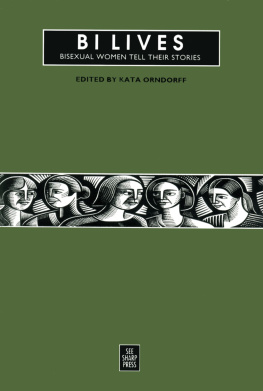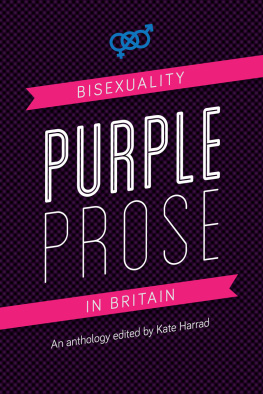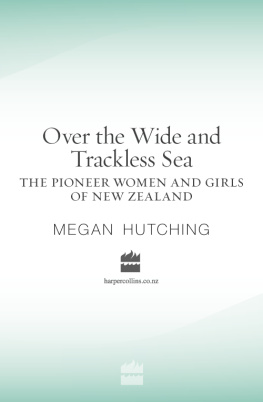Kata Orndorff - Bi Lives: Bisexual Women Tell Their Stories
Here you can read online Kata Orndorff - Bi Lives: Bisexual Women Tell Their Stories full text of the book (entire story) in english for free. Download pdf and epub, get meaning, cover and reviews about this ebook. year: 1999, publisher: See Sharp Press, genre: Home and family. Description of the work, (preface) as well as reviews are available. Best literature library LitArk.com created for fans of good reading and offers a wide selection of genres:
Romance novel
Science fiction
Adventure
Detective
Science
History
Home and family
Prose
Art
Politics
Computer
Non-fiction
Religion
Business
Children
Humor
Choose a favorite category and find really read worthwhile books. Enjoy immersion in the world of imagination, feel the emotions of the characters or learn something new for yourself, make an fascinating discovery.
- Book:Bi Lives: Bisexual Women Tell Their Stories
- Author:
- Publisher:See Sharp Press
- Genre:
- Year:1999
- Rating:5 / 5
- Favourites:Add to favourites
- Your mark:
- 100
- 1
- 2
- 3
- 4
- 5
Bi Lives: Bisexual Women Tell Their Stories: summary, description and annotation
We offer to read an annotation, description, summary or preface (depends on what the author of the book "Bi Lives: Bisexual Women Tell Their Stories" wrote himself). If you haven't found the necessary information about the book — write in the comments, we will try to find it.
Bi Lives: Bisexual Women Tell Their Stories — read online for free the complete book (whole text) full work
Below is the text of the book, divided by pages. System saving the place of the last page read, allows you to conveniently read the book "Bi Lives: Bisexual Women Tell Their Stories" online for free, without having to search again every time where you left off. Put a bookmark, and you can go to the page where you finished reading at any time.
Font size:
Interval:
Bookmark:
Copyright 1999 by Kata Orndorff. All rights reserved. For information contact See Sharp Press, P.O. Box 1731, Tucson, AZ 85702-1731.
Safer Sex appendix copyright 1999 by Rowan Frost.
All rights reserved.
Resources appendix copyright 1999 by Robyn Ochs.
All rights reserved.
Orndorff, Kata, 1950
Bi lives : bisexual women tell their stories / Kata Orndorff. -Tucson, AZ : See Sharp Press, cl999.
252 p. ; 23 cm.
Partial Contents: Safer sex / Rowan Frost - Resources /Robyn Ochs.
ISBN: 1-884365-09-4
1. Bisexual women - Interviews. 2. Bisexuality. I. Title.
306.765082
First Edition June 1999
Cover design and illustration by Clifford Harper. Interior design by Chaz Bufe. The cover and interior are typeset in Avant Garde and Nebraska, a redesigned version of Baskerville.
Appendices
A. Safer Sex (by Rowan Frost)
In this culture everythings got to be yes/no, right/wrong, left/right, black/white. Nothing can be in the middle. To be bisexual means that youre not lesbian. Youre not straight. Youre somewhere where people have trouble dealing.
from Carols interview
Bisexuality is the sexual orientation of a person who is attracted to people of both sexes. This does not mean that every bisexual person feels the need to be involved with both a man and a woman, or that they will have sex with anyone who is available to them. It does not mean, as some lesbians believe, that bisexual women are not serious about any relationship they have with a woman, because (they believe) bisexual women would place more importance on any relationship with a man. Yet these are some of the misconceptions that gay and straight people have about bisexuals. While there are bisexuals who fit these stereotypes, I have not found many of them.
I chose to do a book of interviews with bisexual women because our lives so clearly do not conform to these stereotypes. I wanted to illustrate the reality of several different women, all of whom happen to share the capacity to love and relate sexually to people of both sexes. Each womans interview has been edited with the intention of communicating what is most important to her, and what is most unique and interesting about her life. Each interview is a personal portrait of the many ways that bisexual women live their lives.
Many bisexual women choose to be in monogamous relationships, knowing that their partner could be either sex. Other bisexual women are nonmonogamoussome specifically in order to be in simultaneous relationships with both a man and a woman, others to be open to whomever comes along. Most, but not all, nonmonogamous bisexual women I interviewed are involved in ongoing relationships.
Two of the interviewees are in a polyfidelitous relationship with a man. Polyfidelity is an intimate partnership in which three or more people are all primary partners with each other, are sexual only with these primary partners, and have a lifelong commitment to one another. Group marriage is another name for this type of relationship. People sometimes use the term polyfidelity to describe any nonmonogamous relationship, especially ones with a strong emotional component. The term polyamorous is now often used to describe these kinds of nonmonogamous relationships to distinguish them from polyfidelitous group marriages.
All of these are valid relationship options. It is important that every person choose a way of relating to other people that is right for them. It is equally important that each person be open and honest with any intimate partner as to what that choice is.
In our society, most people think monogamy is the only moral context for sexual relationships. As a result, many people who want to be sexual with more than one person are not honest about this with their primary partner(s). Being honest with ones intimate partner or partners is always an essential ingredient in a healthy relationship and in a life lived with integrity. In this book, several nonmonogamous women appear who are honest with their partners and have integrity in their relationships.
It is also essential to be able to be honest about your sexualityboth with yourself and with the people you are close to. This can be difficult for bisexual women. Many heterosexuals barely tolerate people being in same-sex relationships, while many lesbians are threatened by women who are able to be involved with them and with a man. There are straight people and lesbians who are truly comfortable with bisexual women, but the prospect of coming out, not knowing what peoples reactions will be is frightening to many bisexual women.
I wish we lived in a society where the sex of a persons intimate partner did not matterwhere, as Lani Kaahumanu says in her interview, we would just say that we were sexual and not be defined by the sex of the person we are with. However, we live in a society where heterosexuality is considered the norm. It is important for those who do not fit the heterosexual mold to define their sexuality in order to pressure mainstream society to include same-sex couples in their concept of possible human relationships. It also enables those who are not heterosexual to have a context for their own experience.
For many women, stepping outside the bounds of heterosexual relationships initiates a consciousness-expanding process. It can become clear to a woman in this situation how much time and energy she has expended meeting a mans personal needs and his expectations of how she should be. She may never again be male-defined, that is, seeing herself as someone who needs to be what a man thinks she should be.
In the second wave of feminism in the 70s, women who realized that they were attracted to women called themselves lesbian feminists, as a way of defining this orientation. It seemed to many of them that feminists who were still involved with men were missing a key ingredient of feminist consciousness, and they often viewed themselves as superior to straight feminists. There was no room in their political construct for bisexual feminists. For lesbian feminists, bisexuality was a figment of male imaginationsa fantasy based on the prurient interest of men who couldnt believe that all women werent available to them.
During this time, feminist women were focusing on what it meant to be a woman outside the parameters of the patriarchal male definition of women. A political theory of lesbian feminism evolved based on where a woman chose to put her energy and focus. In this context, sexual desire was not what defined a lesbian; rejecting men and being committed primarily to other woman-identified women did.
Any woman who was a part of the lesbian feminist movement and then got involved with a man was considered to be a traitor, and was often ostracized. Lesbians who found themselves attracted to men had to choose between their real desires and their friends and community. Some women hid their relationships with men from their friends. Many thought of these attractions as a heterosexual phase they would eventually get over, because they were really lesbians.
This way of thinking was predicated on the idea that everyone is either gay or straight. Either you only want to be sexual with people of your own sex, or you only want to be sexual with people of the opposite sex. Because in our society most of us were raised with exposure only to heterosexual pairings, a woman could rationalize that she had been conditioned to be attracted to men. However, she really was a lesbian, because her feminist consciousness and commitment, as well as her attraction to other women, had not changed.
In the 80s some lesbians began to talk and write about desire and feminist erotica, issues that had previously been almost taboo because of the fear among feminists that, like pornography, erotica would be demeaning to women. Some lesbians voiced resentment about trying to fit their desires into what was acceptable to the lesbian feminist community. The idea was born that womens real desires needed to be incorporated into the dictates of feminism, and it became more acceptable to base ones sexuality on ones desires. In this context, more women were able to acknowledge that they were bisexual.
Next pageFont size:
Interval:
Bookmark:
Similar books «Bi Lives: Bisexual Women Tell Their Stories»
Look at similar books to Bi Lives: Bisexual Women Tell Their Stories. We have selected literature similar in name and meaning in the hope of providing readers with more options to find new, interesting, not yet read works.
Discussion, reviews of the book Bi Lives: Bisexual Women Tell Their Stories and just readers' own opinions. Leave your comments, write what you think about the work, its meaning or the main characters. Specify what exactly you liked and what you didn't like, and why you think so.





